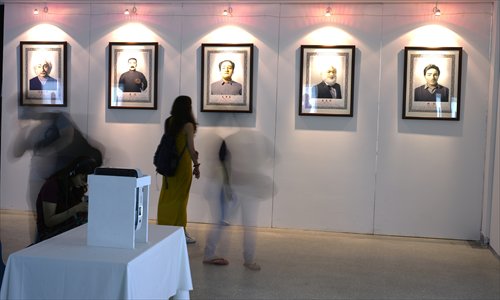History channelers

Photos show Jiang Chunlin in different masks at the Art Museum of CAFA. Photo: Courtesy of Jiang Chunlin
If you had the chance to talk with Karl Marx, Albert Einstein or Marcel Duchamp, what would you ask them? What answers would you expect?
Jiang Chunlin, an experimental art graduate from the China Central Academy of Fine Arts (CAFA) turned this idea into his final project, a video installation in which he performs as five famous people from history, including Mao Zedong and Chinese writer Lu Xun, and asks them questions.
Though these familiar names may seem removed from modern people's daily lives, Jiang asserts that they are still influencing life today in a way that often goes unrecognized.
By asking these historical bigwigs questions regarding 21st century issues, the video makes an interesting connection between the education that most Chinese students have received in the past few decades and the social and ideological outcomes of this kind of education.
For Jiang, it is a puzzle-solving process for the questions and contradictions left over from his childhood and adolescence.
Process of inspiration
According to Lü Shengzhong, director of the experimental art department at CAFA, Jiang's project was originally developed from a class exercise in which Jiang shared his personal experience of being influenced by Lu Xun, the early 20th-century writer whose articles were commonly seen in textbooks for primary and middle school students.
"[There is an] influence from the idealist education and role model setting, [which] was formulaic and inert. The topic resonated with classmates and led to a lot of discussion," Lü told the Global Times.
Jiang later performed as Lu Xun for other classmates, asking questions such as "Why did you switch your career from a doctor to a writer?" or "Did you despise being a doctor because many of them take bribes?"
The experience of pretending to be Lu Xun and talking the style of his writing turned out to be a real task for Jiang.
He found himself exhausted and sweaty after finishing answering all the questions from the student representatives. But the difficult process also pushed him to continue developing the idea into an hour-long video project.
Born in 1987 and growing up in Hunan Province, Jiang finds that the influence from the five historical figures he selected is "everywhere" in his life.
Taking Marx as an example, Jiang said that people often refer to the concepts of "principal contradiction" and "secondary contradiction." The use of these terms has become so common, he said, that people can almost forget they are not Chinese phrases but concepts from Marx, a German.
Marxist philosophy is taught in high schools and is also a compulsory course for every single student in Chinese colleges.
In the process of spreading Marx's ideas, Jiang said, the interpretation of his theories gained a bit of Chinese flavor, giving the public the impression that Marx is Chinese.
Thus, in the video, Jiang comically asks himself as Marx, "How are you settling into life in China? And how do you feel about the economic development here?"
Personal and societal
Jiang spent a lot of time preparing the masks of the five historical figures and brought in professionals to do his makeup. However, he only appears as a silhouette in the video. After each conversation finishes, the camera moves in to capture Jiang removing his mask.
"The unexplainable parts in an artwork are the most useful and interesting ones," he said.
Jiang insists on holding a neutral attitude in terms of his work. He intentionally makes the performance seem clunky and the dialogs sound all over the place, mixing truth and fiction.
On the one hand, he feels "copying another person is a stupid act" and he is in the end asking and answering only to himself. On the other hand, he said he needs to borrow the "shell" of the five great people to imagine how they would consider the questions.
"It's a process of fighting with myself in a way that removes professional acting elements and is just direct and honest," said Jiang, remarking that the exciting thing about being an artist is creating work that contains questions without answers.
Lü said there's a commonality of experience among the 1980s generation: they see a chasm between having a personal identity and accepting the role models which they've been taught to admire. As the cohort matures and reflects on its education, contradictions arise - contradictions now fueling their creativity.
Generational reflections
Many media outlets have reported on the CAFA graduation exhibition this year. Jiang's work was one of the hundreds that addressed the social development and changes of China.
Postgraduate Chen Mingqiang's artwork, which records and studies the changes of Chinese marriage certificates since 1949, also caught the attention of the media.
Other artwork addresses immigration issues and financial pressures.
The ways young artists today interact with society, past and present, show through in their creations. Several pieces, including Jiang's video, were collected by an Australian art museum.
More importantly, these interactions lead to a unique artistic expression that differs from the past. Lü said that unlike many of the older generations of artists that intended to break the law and rail against tradition to achieve avant-garde effects, these young artists care more about being honest with themselves.
They develop a relationship between self and society based on personal experience, focusing on the very core part of the content instead of artistic flourishes.
"Without adding avant-garde features, their work emphasizes current local issues that already contain modern attributes," he said.
For Lü, the fact that young artists are looking to raise the bar and not basing it on Western criteria shows great progress in Chinese artists' confidence and potential.